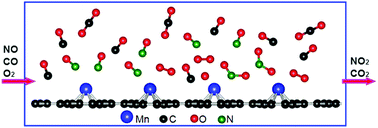Single-atom metal-modified graphenylene as a high-activity catalyst for CO and NO oxidation†
Abstract
Herein, the adsorption behaviors and interactions of different gas species on single-metal atom-anchored graphenylene (M–graphenylene, M = Mn, Co, Ni, and Cu) sheets were investigated by first-principles calculations. At first, the single metal atom tends to adsorb on the hollow or bridge site of graphenylene, and the formed M–graphenylene systems exhibit varied magnetic properties. The reactants (NO, CO, O2, O, CO2, and NO2) adsorbed on the Mn–, Co–, and Ni–graphenylene sheets exhibit higher stability than those adsorbed on the Cu–graphenylene sheet. Moreover, the co-adsorption configurations of NO–O2, CO–O2, 2NO, and 2CO on the M–graphenylene sheets were comparably studied, which are considered as the initial states for NO and CO oxidation. It was found that the energy barriers for the formation of OONO and OOCO complexes on Mn–graphenylene by the Langmuir–Hinshelwood (LH) mechanism are larger than those in the case of Co–graphenylene (<0.4 eV). The possible reactions for the oxidation of 2CO by the 2NO molecules on the M–graphenylene sheets were also considered, because of the adsorbed NO molecules are more stable than the CO and O2 molecules. Furthermore, the energy barrier for the oxidation of CO on Mn–graphenylene via the Eley–Rideal (ER) mechanism (2NO + 2CO → 2CO2 + N2) is smaller (<0.3 eV) than those in the cases of other substrates. These results illustrate that the single-metal atom-modified graphenylene can be used as a potential novel carbon-based catalyst with high activity.



 Please wait while we load your content...
Please wait while we load your content...